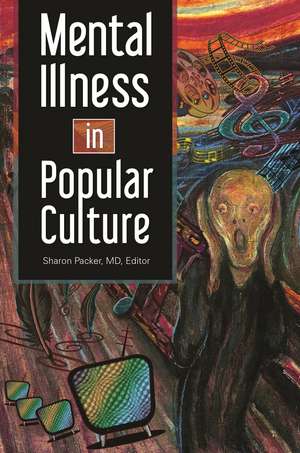Mental Illness in Popular Culture
Editat de Sharon Packer MDen Limba Engleză Hardback – 23 mai 2017 – vârsta până la 17 ani
Preț: 371.13 lei
Preț vechi: 483.68 lei
-23% Nou
Puncte Express: 557
Preț estimativ în valută:
71.02€ • 74.33$ • 59.11£
71.02€ • 74.33$ • 59.11£
Carte tipărită la comandă
Livrare economică 31 martie-14 aprilie
Preluare comenzi: 021 569.72.76
Specificații
ISBN-13: 9781440843884
ISBN-10: 1440843880
Pagini: 392
Dimensiuni: 156 x 235 mm
Greutate: 0.84 kg
Editura: Bloomsbury Publishing
Colecția Praeger
Locul publicării:New York, United States
ISBN-10: 1440843880
Pagini: 392
Dimensiuni: 156 x 235 mm
Greutate: 0.84 kg
Editura: Bloomsbury Publishing
Colecția Praeger
Locul publicării:New York, United States
Caracteristici
Spotlights examples of how popular culture such as comedies mirror changing attitudes toward mental illness and are helping pave the path to greater acceptance
Notă biografică
Sharon Packer, MD, is a practicing psychiatrist and psychopharmacologist and an assistant professor of psychiatry.
Cuprins
IntroductionSharon Packer, MDPart One Cinema: The Big ScreenChapter 1 Psychoanalytic Renditions and Film Noir TraditionsRosa JH BerlandChapter 2 The Meme of Escaped (Male) Mental Patients in American Horror FilmsJeffrey BullinsChapter 3 Filming Hallucinations for A Beautiful Mind, Black Swan, Spider, and Take ShelterJocelyn DupontChapter 4 Dissociative Identity Disorder in Horror Cinema (You D.I.D.n't See That Coming)Michael MarkusChapter 5 Spirit Possession, Mental Illness, and the Movies, or What's Gotten into You?Sean MorelandChapter 6 Hitchcock: Master of Suspense and Mental IllnessMark O'HaraChapter 7 McMurphy the Trickster, Foucault, and One Flew Over the Cuckoo's NestMark O'HaraChapter 8 "Nature Played Me a Dirty Trick": Illness vs. Tolerance in Gay-Themed FilmEric J. SterlingPart Two Television: The Small ScreenChapter 9 Women's Agency as Madness: "The Yellow Wallpaper" to Penny DreadfulLaura E. Colmenero-ChilbergChapter 10 Orange Is the New Color for Mental IllnessMary L. Colavita, Kate Lieb, Alexis Briggie, Sonal Harneja, and Howard L. FormanChapter 11 Suffering Soldiers and PTSD: From Saigon to Walton's MountainHaley Gienow-McConnellChapter 12 Mirth and Mental Illness: Television Comedy and the Human ConditionKristi Rowan HumphreysChapter 13 Mentally Ill Mobsters: From Cagney's White Heat to Scarface to Bugsy and Crazy JoeVincent LoBruttoChapter 14 How Traditional Holiday TV Movies Depict Mental IllnessMartin J. ManningChapter 15 Cotard's Syndrome in True Detective, Alien Invaders, Zombies, and Pod PeopleW. Scott PooleChapter 16 House, Monk, Dexter, and Hannibal: "Super-Powered" Mentally Ill TV CharactersLisa SpiekerPart Three Novels, Poetry, Memoirs, and Short StoriesChapter 17 Sanity and Perception in Philip K. Dick's Clans of the Alphane MoonAaron BarlowChapter 18 Medea, Mothers, and Madness: Classical Culture in Popular CultureDaniel R. FredrickChapter 19 Narratives in The Snake Pit, I Never Promised You a Rose Garden, and Girl, InterruptedJessica N. LeeChapter 20 Edgar Allan Poe's Unreliable Narrators, or "Madmen Know Nothing"Caleb PuckettChapter 21 Lovecraft and "An Open Slice of Howling Fear"Eric SandbergPart Four Comics, Art, Graphic Novels, and Video GamesChapter 22 Mind Games: Representations of Madness in Video GamesShawn EdreiChapter 23 Graphic Narratives: Bechdel's Fun Home and Forney's MarblesNicole EugeneChapter 24 The X-Men as Metaphors: When Gayness Was IllnessMariel Freeman LifschutzChapter 25 Arkham Asylum's Criminally Insane Inmates and Psychotic PsychiatristsSharon PackerChapter 26 Halfworld's Loonies in Rocket Raccoon Comics-Serious or Satire?Sharon PackerChapter 27 Van Gogh and the Changing Perceptions of Mental Illness and ArtE. Deidre PribramChapter 28 From the Beats to Jean-Michel Basquiat: Cultural Madness and Mad ArtMorgan ShipleyChapter 29 "Autists" and Merchandising "Autistic Art"Leni Van GoidsenhovenChapter 30 Slipping into Silent Hill: Transnational TraumaBrenda S. Gardenour WalterPart Five Music, Musicians, and Musical TheaterChapter 31 Kurt Cobain, Nirvana, and Generation X's Suicide SymbolRobert L. Bryant, Daniel Schwartz, and Howard L. FormanChapter 32 Metallica, Heavy Metal, and "Suicide Music"Adam W. Darlage and Paul "Hoagy" BurtonAbout the Editor and ContributorsIndex
Recenzii
[A]n interesting new account of mental illness and its multitude of representations in popular culture. . . . The book will prove useful for more advanced students, faculty, or other individuals interested in the various forms of mental illness represented in areas of popular culture. Summing Up: Recommended. Upper-division undergraduates and above; faculty and professionals.
